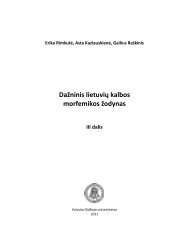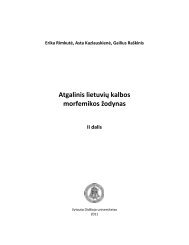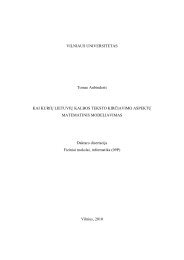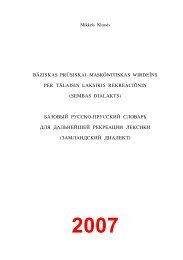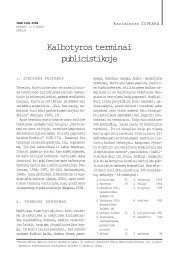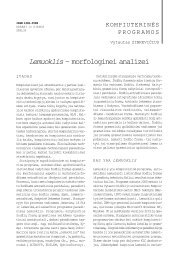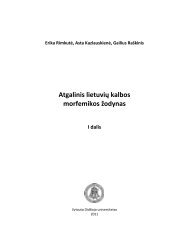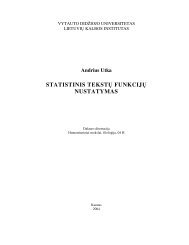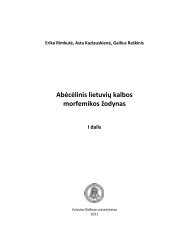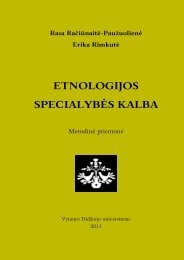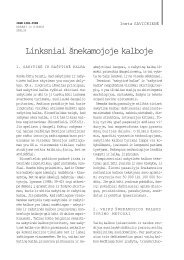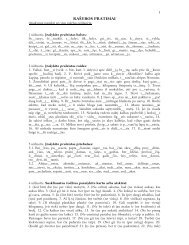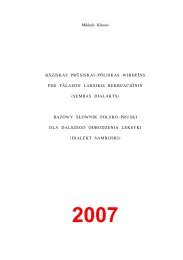HISTORICAL GRAMMAR OF OLD PRUSSIAN
HISTORICAL GRAMMAR OF OLD PRUSSIAN
HISTORICAL GRAMMAR OF OLD PRUSSIAN
You also want an ePaper? Increase the reach of your titles
YUMPU automatically turns print PDFs into web optimized ePapers that Google loves.
<strong>HISTORICAL</strong> <strong>GRAMMAR</strong> <strong>OF</strong> <strong>OLD</strong> <strong>PRUSSIAN</strong><br />
15<br />
Vocalism<br />
a) Short vowels<br />
* 6. The short vowel Pr. *i comes from Balt. *i < IE *Ÿ and corresponds<br />
to Lith. i and Latv. i, cf.: Pr. is ‘from’ – Lith. Ñð (dial. iþ), Latv. iz;<br />
Pr. acc. kittan ‘other’ – Lith. kÑtà, Latv. cits; Pr. wissa – Lith. vÑsas, Latv.<br />
viss etc. There are instances of a syncopated short i in Prussian. e.g.:<br />
camstian ‘sheep’ (E) < *kamist’an (PEÞ II 105 ff.), werstian ‘calf’ (E) <<br />
*versist’an (PEÞ IV 231) 6 etc. In written documents short Pr. *i sometimes<br />
is rendered with the letter e, e.g.: camenis ‘hearth’ (E) < *kaminas<br />
(PEÞ II 103 f.), pekollin ‘hell’ (I) < *pikulin (for the spelling pyculs III<br />
reflecting *pik- see PEÞ III 280) etc. This shows an open character of Pr.<br />
*i (cf. Girdenis, Maþiulis in: Girdenis KD III 413 ff.). This does not<br />
contradict to such sample as meltan (E) ‘meal (fluor)’ (= *miltan), of course.<br />
For the phonetic value of the segment -el- cf. PEÞ III 125 f. as well as * 2.<br />
* 7. It is Baltic *Šu in which Pr. u, Lith. u and Latv. u originate, cf.:<br />
Pr. duckti ‘daughter’ (E) < *duktç (PEÞ I 235) – Lith. duktú; Pr. budç<br />
‘(they) are awake’ (III) – Lith. budêti, bùdinti and Latv. budinât ‘to wake’.<br />
That the short Pr. u was open in its turn (cf. about the Pr. i above), is<br />
witnessed again by the spelling, i.e. by variating o / u (cf. Girdenis KD l.<br />
c.), e.g.: Pr. meddo ‘honey’ (E) < *medu (the final inflection *‹u being<br />
unstressed, cf. PEÞ III 118) – Lith. medùs, Latv. medus; Pr. prusnan /<br />
prosnan ‘face’ (III) – Lith. prusn‡a ‘snout’, Latv. (pl.) prusnas ‘lips, mouth’<br />
(PEÞ III 361); druwç (III) / drowy (II) ‘(I) believe’. One should also pay<br />
attention to frequent rendering of ‹u with the letter o in unaccented<br />
inflexional morphemes in the Catechisms: acc. sg. dangon ‘heaven’ (I,<br />
III), sounon ‘son’ (III beside sunun I) etc., or if. daton ‘to give’ (III), bûton<br />
‘to be’ (III), pûton ‘to drink’ with -on instead of -un too, as well as pc. pt.<br />
act. auginnons ‘having grown’ (III) with -ons instead of -uns.<br />
* 8. Pr. *‹e comes from Balt. *‹e < IE *‹e and corresponds to Lith. e<br />
6 More precisely: camstian = *kamst’an or (sometimes supposed by Maþiulis earlier) *kamstjan<br />
< *kamistjan, werstian = *verst’an or werstjan < *versistjan – L.P.



